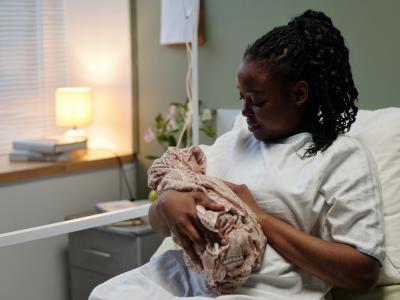B117 shows similar aerosol stability as other strains
The COVID-19 B117 strain, which was first identified in the United Kingdom, has similar aerosol stability compared with three other COVID strains, so transmissibility differences are most likely due to other factors, according to a study last week in The Journal of Infectious Diseases.
The researchers looked at an isolate of B117 as well as three other COVID-19 strains (hCoV-19/France/IDF0372/2020, hCoV-19/USA/NY-PV08449, and hCoV-19/USA/WA-1/2020), testing the effects of light, humidity, and temperature on aerosols from a simulated respiratory tract lining fluid (sRTLF) in a rotating drum chamber.
No difference was identified in the absence of sunlight at 20°C or 40°C, but a small significant difference was seen in some aerosols when exposed to sunlight at 20°C and 20% relative humidity. Test conditions included 10°C and 30°C in darkness and full-intensity sunlight at 70% relative humidity.
"For each isolate, mean kinfectivity values [the decay constant for viral infectivity] were significantly higher in simulated sunlight than in darkness," the researchers write, noting that the data suggest all four would be "rapidly inactivated" by real-world sunlight. "There were no differences in the decay constants between isolates in darkness at either 20°C or 40°C, with a mean time for a 90% loss of viral infectivity across all dark conditions of 6.2 hours."
Aerosol transmission is affected by more than decay rate, though, the researchers cautioned. The amount of virus emitted, the origins of the viral particles (eg, lung vs saliva), mutations changing which cells the virus affects, and other factors can change transmissibility.
Apr 2 J Infect Dis study
Study: Venous thromboembolism not increased in COVID outpatients
Thirty-day incidence of venous thromboembolism (VTE) does not appear to have a greater association with outpatients infected with COVID-19 compared with non-infected adults, according to a research letter today in JAMA Internal Medicine.
The researchers looked at 220,588 adults tested for COVID-19 from Feb 25 to Aug 31, 2020, in the Kaiser Permanente Northern California health plan. After excluding patients who were asymptomatic at the time of testing or who had previously received anticoagulants, 26,104 (11.8%) were included in the positive COVID subgroup.
VTE occurred in 198 patients with a positive COVID test (0.76%) and 1,008 people with a negative COVID-19 test (0.52%). Of the 117 who had an outpatient COVID test and then developed VTE, 89 (76.1%) also needed hospitalization later on.
Overall, 30-day VTE incidence was 4.7 per 1,000 individuals who tested positive for COVID-19 versus 1.6 in those who tested negative. COVID patients who needed hospitalization were more associated with VTE compared with those who didn't have COVID but were hospitalized (5.8 vs 3.0 cases per 1,000 individuals tested), but no significant difference was seen in incidence for infected versus non-infected outpatients.
"These findings suggest that VTE incidence outside of the hospital is not significantly increased with SARS-CoV-2 infection and argue against the routine use of outpatient thromboprophylaxis outside of clinical trials," the researchers write. Because COVID-19 symptoms have been seen in individuals months after the original diagnosis, however, the researchers add that studies may also need to look at 90-day VTE potential.
Apr 5 JAMA Intern Med research letter
Campylobacter in raw milk sickens 5 in Washington state
Health officials in Washington state said they have identified five campylobacteriosis infections in people who recently drank raw milk from a creamery in Sequim, according to an Apr 2 Washington State Department of Health (WSDH) statement.
The raw milk from Dungeness Valley Creamery was bought in four different counties, and the company has voluntarily recalled all of its raw milk with a "best buy" date of Apr 13 or earlier, due to potential contamination with Campylobacter.
Scott Lindquist, MD, MPH, state epidemiologist for communicable diseases, said, "Unpasteurized raw milk can carry harmful bacteria and germs. Foodborne illnesses can be caused by many different foods; however, raw milk is one of the riskiest."
Campylobacter infection symptoms include fever, diarrhea, nausea, and malaise. Patients often recover on their own, but some, such as infants, seniors, and people with weakened immune systems, can experience more severe symptoms.
Apr 2 WSDH statement











